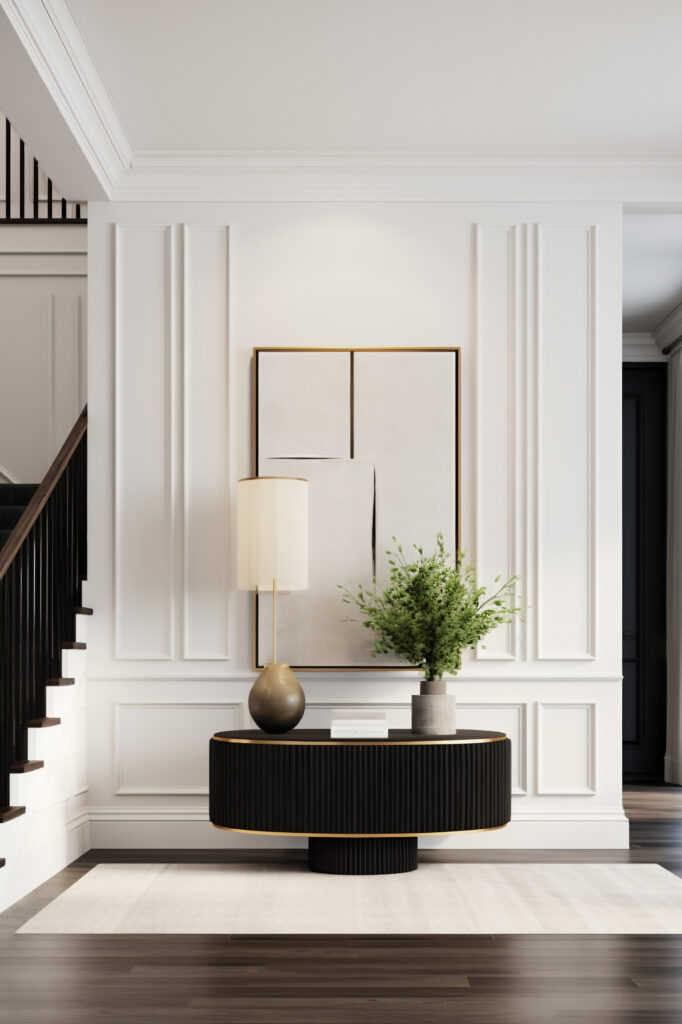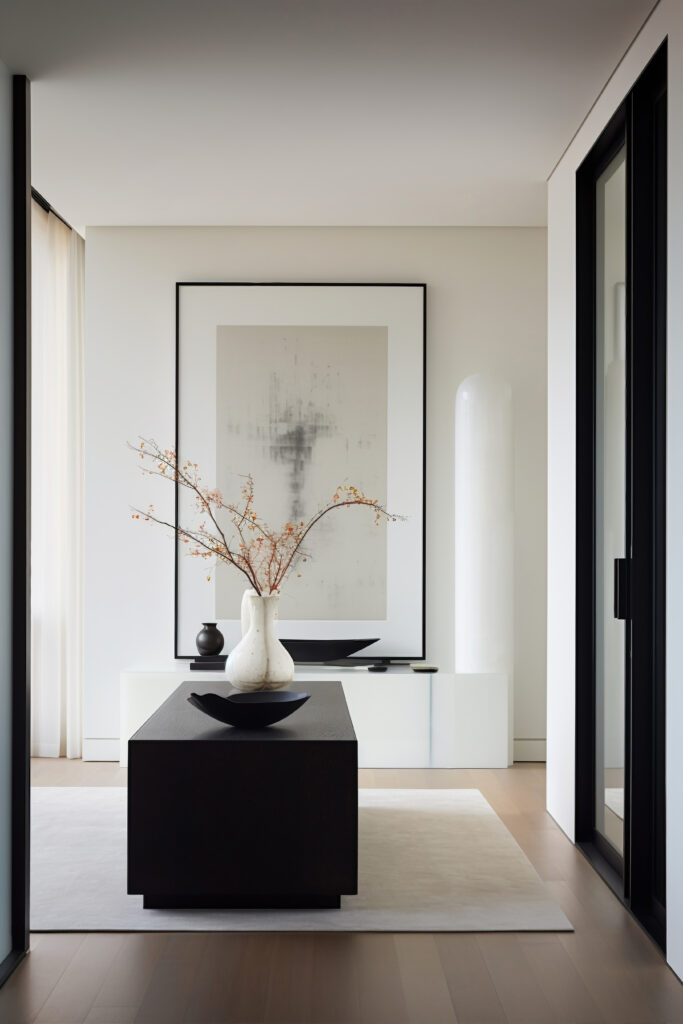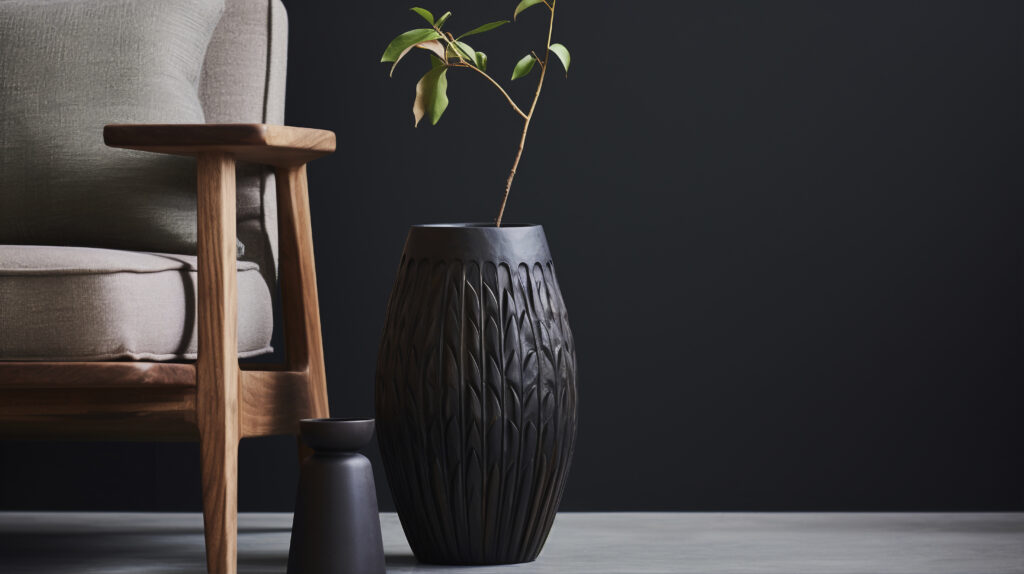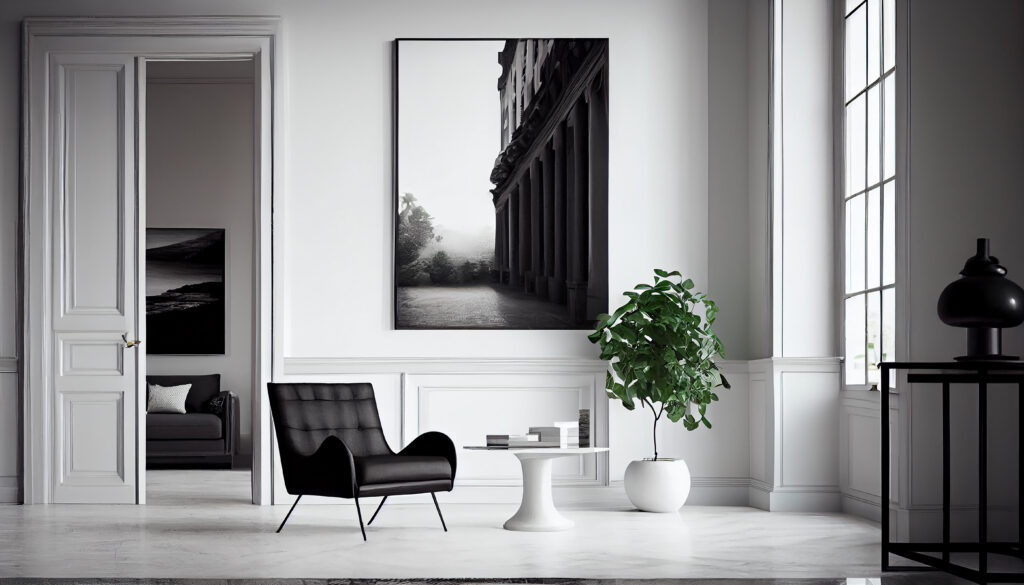Introduction
Monochrome styling is more than a color choice; it’s a lifestyle. Black-and-white decor offers a timeless appeal, combining elegance with simplicity. However, creating a monochrome room that feels warm and balanced—rather than stark or sterile—takes careful planning. This guide will show you how to style a black-and-white space that feels inviting, stylish, and full of personality.
Why Choose a Monochrome Palette for Your Home?
A black-and-white palette can transform any space, offering a look that’s both timeless and versatile.
Sophistication and Elegance
Black and white add an instant sense of sophistication. Unlike bold color schemes, a monochrome palette is both subtle and striking. This unique balance makes any room feel more polished.
Timeless Style
Monochrome decor is not dependent on changing trends. While other colors come and go, black and white stay in style, ensuring that your space will look fresh for years.
Adaptability Across Styles
Whether you prefer a modern, classic, or eclectic style, black and white provide a neutral foundation. This adaptability allows you to add unique touches without overwhelming the space.
Read about the psychology behind monochrome design on mariakillam.com for insight on why black-and-white spaces feel so balanced and calming.

Setting the Foundation – Choosing Your Monochrome Base
One of the first steps in monochrome design is deciding on your dominant color.
White-Dominant Spaces
Choosing white as the primary color creates a bright, open feel. White reflects light and can make smaller rooms feel larger. This approach works especially well in rooms with limited natural light. For balance, you can add black accents like picture frames or small decor items.
Black-Dominant Spaces
Alternatively, black brings drama and depth. It’s an ideal choice for cozy spaces, feature walls, or rooms with plenty of natural light. However, black needs balancing elements like white furniture or lighter decor pieces. This contrast prevents the space from feeling closed-in.
Choosing your base color sets the mood and allows for a creative mix of black-and-white accents. This choice creates a cohesive, intentional look that reflects your style. With these ratios, you’ll establish harmony, making sure neither color overpowers the other.
Balance is Key in Monochrome Design
Achieving a balanced look is essential in a black-and-white room. One common technique is the 70-30 or 60-40 rule. This approach uses one color for most of the space, while the other acts as an accent.
Creating Harmony in a White-Dominant Room
In a white-dominant room, black accents add contrast and interest. Consider adding black frames, furniture legs, or a patterned rug. These elements prevent the room from feeling overly bright or bland.
Adding Contrast in a Black-Dominant Room
In a black-dominant room, white accessories lighten the space. For example, a white sofa or a few light-colored pillows can soften the boldness of black. This mix creates harmony, keeping the room from feeling too intense or overpowering.
By balancing colors in this way, you achieve visual harmony that feels both cohesive and comfortable.

Layering Textures to Add Depth and Warmth
Textures play an important role in monochrome design. They prevent the space from feeling flat and add depth.
Choosing Textured Fabrics
Textured fabrics like velvet, linen, or wool bring a tactile quality to a black-and-white room. For example, a black velvet sofa paired with a white linen throw creates a layered, inviting look.
Rugs and Curtains
Rugs with patterns or textured curtains add dimension to the room. In monochrome settings, these elements give the space a warmer, more welcoming feel.
Using Natural Materials
Incorporate natural items like wooden furniture, woven baskets, or ceramic vases. These materials add a touch of organic warmth that complements the sleek look of black and white.
With these textures, your monochrome decor will feel richer and more engaging.
Patterns that Complement Black-and-White Decor
Patterns add energy and variety to a monochrome room without introducing new colors.
Geometric Patterns
Geometric shapes like stripes, chevrons, or grids bring a modern feel. A striped rug or a chevron cushion can add interest while keeping the monochrome theme intact.
Organic Patterns
Floral or nature-inspired patterns work well in bedrooms or living areas, creating a more relaxed, inviting look.
Mixing these patterns keeps the room visually dynamic. Pairing them with solid colors ensures the space remains calm and cohesive.
Highlighting Accents for a Lively Touch
Well-chosen accents make a monochrome space more vibrant. These elements break up the palette and add personality.
Adding Statement Cushions and Throws
Use patterned cushions or textured throws on monochrome furniture. These items provide warmth and create focal points in the room.
Including Decorative Items
Decorative items like candles, sculptures, or vases in unique shapes bring character to the space. These accents draw the eye and keep the room from feeling too uniform.
Accents allow for easy updates, giving you the flexibility to refresh your space without changing the overall color scheme.
The Impact of Lighting in a Monochrome Space
Lighting is essential in black-and-white decor. It highlights contrasts and can soften the overall look.
Emphasizing Natural Light
Natural light enhances the brightness of a white-dominant room or softens the boldness of a black-dominant one. Sheer curtains allow light to filter in gently, creating a comfortable ambiance.
Using Artificial Lighting
Combine overhead lights, floor lamps, and table lamps for a layered effect. Soft LED bulbs help you create a warm, inviting atmosphere.
Good lighting transforms a monochrome room, adding depth and enhancing its cozy appeal.
Using Art to Make a Statement in Monochrome
Art is an excellent way to personalize a black-and-white space. It adds depth and can act as a focal point.
Selecting the Right Artwork
Black-and-white photos, abstract paintings, or sculptures blend seamlessly into a monochrome palette while adding character.
Playing with Scale and Placement
A large art piece on a plain wall creates a dramatic effect, while smaller artworks arranged gallery-style add sophistication to a hallway or living room.
Artwork allows you to express your taste and brings the whole room together.

Finding Balance with Functional and Decorative Items
To create a cohesive look, balance functional items with decor.
Functional Pieces that Double as Decor
Storage units, shelving, and tables in black or white keep the room practical and visually pleasing.
Complementing with Decorative Items
Add small touches like books, candles, or sculptures to make functional pieces feel more personal.
This approach ensures your space remains both stylish and practical.
Styling with Greenery for a Fresh Contrast
Adding plants brings life to a monochrome room, giving it a fresh, organic touch.
Choosing the Right Plants
Deep green plants like snake plants, ZZ plants, and monstera stand out beautifully against black and white.
Stylish Pots and Stands
Use white pots or black stands to keep the look consistent. These containers emphasize the contrast of green foliage against the monochrome palette.
Greenery adds a refreshing element, breathing life into the room and softening the overall aesthetic.
Avoiding Common Monochrome Decor Pitfalls
Here are a few common pitfalls to avoid for a balanced, inviting space.
Avoid Too Much White
Too much white can feel clinical. Balance it with black accents and warm textures to make the room feel more welcoming.
Prevent Overuse of Black
While black is bold, overusing it can feel heavy. Lighten the space with white elements and natural lighting to avoid a dark, confined look.
Skip Over-Minimalism
A monochrome palette can feel too minimal at times. Personalize it with patterns, textures, and accents to add warmth and personality.
By avoiding these pitfalls, you’ll create a balanced, stylish monochrome space.

Conclusion: Embracing the Timeless Charm of Monochrome
Black-and-white decor is timeless, sophisticated, and endlessly adaptable. By thoughtfully balancing colors, adding textures, and selecting personal accents, you can create a monochrome home that’s uniquely yours. With NoirBlanc’s curated selection of monochrome products, bringing this classic look into your home has never been easier.
FAQs
1. Is monochrome decor suitable for small spaces?
Yes, monochrome decor can be ideal for small spaces. A white-dominant palette creates a sense of openness, making small rooms appear larger. Black accents add depth and prevent the room from feeling too bright or bland. Keeping patterns minimal and choosing well-placed decor can also keep the room from feeling cluttered.
2. How can I add color to a black-and-white space if I want a small pop of color?
To add a pop of color without overpowering the monochrome look, consider a single accent color like deep green, navy, or metallics. Try adding a colorful cushion, an artwork with subtle color, or a gold-framed mirror. These items introduce variety while keeping the overall look elegant.
3. What are the best materials for a monochrome space?
Materials like velvet, linen, and wool add warmth to a black-and-white room. For example, black velvet adds luxury, while white linen keeps things light. Marble, with subtle veining in black and white, can bring elegance to spaces like kitchens and bathrooms. Wood and ceramics also complement monochrome, adding an organic touch.
4. Can I add metallic accents in a monochrome room?
Yes, metallic accents like silver, chrome, or matte gold add a luxurious touch to a black-and-white room. They work well in lighting fixtures, mirror frames, and decor. However, keep metallic accents minimal and consistent for a cohesive look.
5. How can I keep my black-and-white room looking fresh over time?
To keep a black-and-white room fresh, update small accents like cushions, throws, and decor regularly. Seasonal items can add variety without disrupting the monochrome palette. Adding textures or greenery also helps keep the room lively and inviting. Finally, regular cleaning is essential, as black shows dust and white can reveal stains. Clean surfaces keep the room looking crisp and stylish.

